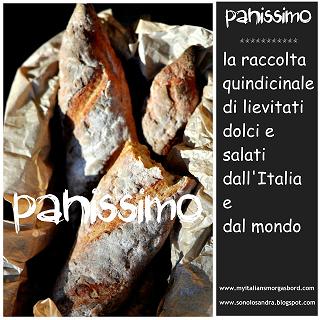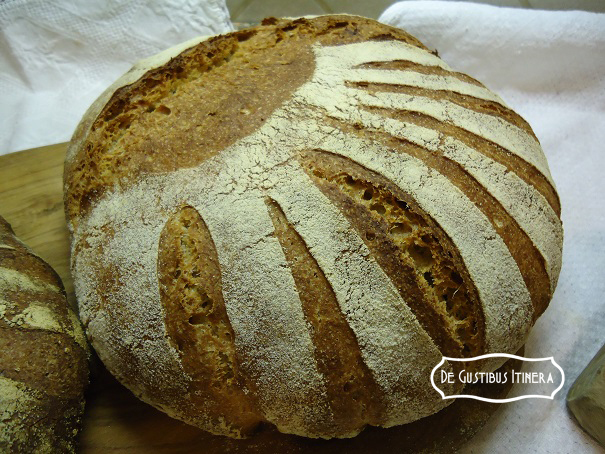Stavolta vi presento un pane che...si impasta quasi da solo!
Molto molto semplice, richiede poco tempo e l'utilizzo di un solo tipo di farina, la farina integrale di grano tenero, a differenza di tante altre mie ricette, che prevedono un blend di farine.
A dire il vero ho scelto una farina davvero speciale, una monocultivar dal MOLINO COFELICE, farina integrale di grano tenero BIANCHETTA, un grano antico di spiccato carattere e ottima fragranza.
This time I present a bread...that almost kneads itself!
Very very simple, it requires little time and the use of only one type of flour, wholemeal wheat flour, unlike many other recipes in my blog, which provide a blend of flour.
Actually, I chose a really special meal, a monocultivar from MOLINO COFELICE, wholemeal wheat BIANCHETTA, an ancient grain with a marked character and a great fragrance.
Pane integrale senza impasto ad alta idratazione
Ingredienti:
1 kg di farina di grano tenero integrale macinata a pietra (io ho usato la monocultivar “Bianchetta” del MOLINO COFELICE)
180 gr di lievito liquido al 130%
780 gr di acqua
12 gr di sale
Per questo pane ho deliberatamente evitato il malto, temendo un’eccessiva azione degli enzimi in presenza di una farina integrale.
Wholemeal no-kneaded bread, high hydration
Ingredients:
1 kg of stone-ground whole wheat flour (I chose the monocultivar “Bianchetta”, COFELICE MILL)
180 grams of liquid sourdough 130% hydration
780 grams of water
12 grams of salt
For this bread, I deliberately avoided the malt, fearing an excessive action of enzymes in a wholemeal flour.
Sciogliere bene il lievito nell’acqua, agitare con una frusta fino alla comparsa di fitte bollicine. Aggiungere la farina setacciata. Mescolare fino a far amalgamare bene, ma senza lavorare troppo l’impasto.
Far riposare per mezz’ora, coperto.
Aggiungere il sale, in modo omogeneo, facendo contemporaneamente lo S&F, cercando di inglobare aria e facendo attenzione a non creare strappi. Ripetere l’operazione ancora una o due volte, a distanza di dieci, quindici minuti, fino a rendere l’impasto liscio ed incordato.
Lasciar puntare l’impasto per un’ora, coperto.
Formare due o tre pagnotte, con giusta pirlatura, coprirle con abbondante semola e porle nei cestini per la lievitazione. Attendere ancora quaranta minuti circa, per far partire bene la lievitazione, poi porre i cestini in frigo per 12 ore.
Preparare il forno alla massima temperatura, possibilmente con refrattaria. Tirar fuori i cestini 10 minuti prima di infornare, dopo aver controllato la lievitazione delle pagnotte (come al solito devono raddoppiare).
Capovolgere le pagnotte sulla paletta, praticare i tagli, vaporizzare ed infornare.
Io ho fatto due pagnotte, come si può vedere dalle foto (le altre due che si vedono sullo sfonfo sono in pura semola, le presenterò in un altro articolo), e per questo formato piuttosto grande occorrono circa 45-50 minuti di cottura, i primi 15 alla massima temperatura, poi a 220° e infine a 200°. Gli ultimi 7-8 minuti in fessura per favorire la fuoriuscita del vapore e rinforzare la crosta.
Dissolve the sourdough in the water, stir with a whisk until the formation of dense bubbles. Add the sifted flour. Mix well, but without overworking the dough.
Let it rest for half an hour, covered.
Add the salt, uniformly, making the S&F at the same time, trying to incorporate air and being careful not to create tears. Repeat once or twice, every ten or fifteen minutes, until the mixture is smooth.
Allow the dough to rest for an hour, covered.
Form two or three loaves, with the right shaping, cover with plenty of flour and place them in the baskets for the leavening. Wait forty minutes again, to allow the leavening to start well, then put the baskets in the fridge for 12 hours.
Preheat the oven at the highest temperature, possibly with baking stone. Pull out the baskets from the fridge 10 minutes before baking, after checking the right rising of the loaves (as usual they must double).
Turn the loaves on the baker’s shovel, score them, spray steam in the oven and bake.
I made two loaves, as you can see in the photos, for this size it takes about 45-50 minutes of cooking, the first 15 at the maximum temperature, then at 220 ° C and finally to 200 °. The last 7-8 minutes with a slot in the door, to facilitate the leakage of steam and to reinforce the crust.
Remove from the oven and allow the loaves to dry on the grid.
Questo articolo partecipa alla raccolta #PANISSIMO 22, delle amiche Sandra e Barbara, ospitata per il mese di ottobre in questo blog.

Partecipa anche alla raccolta dell'amica polacca Zapach chleba











Commenti
grazie per ospitare panissimo cara!
Sandra
Baci Maria Teresa
pasta madre solida ? Ed in quale quantita' ? Grazie e buona giornata !
Grazie per essere passata di qui!
RSS feed dei commenti di questo post.